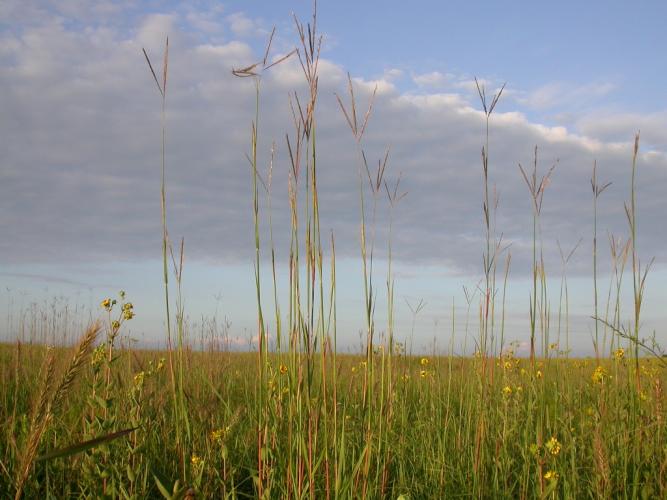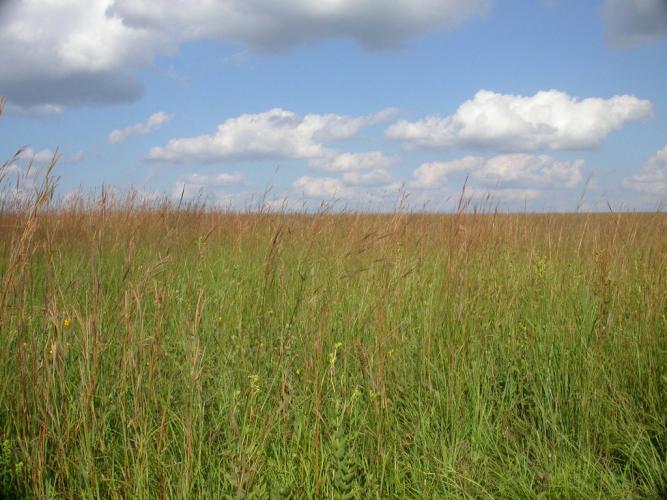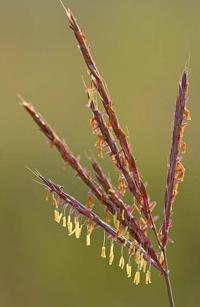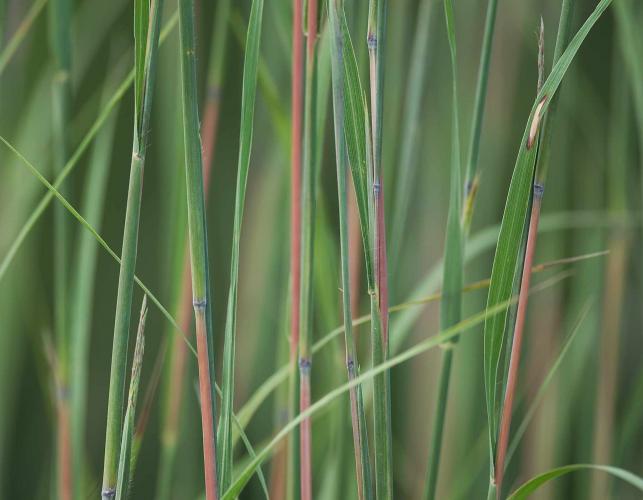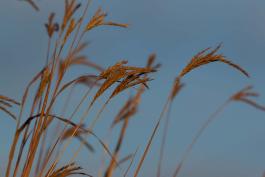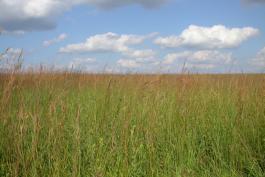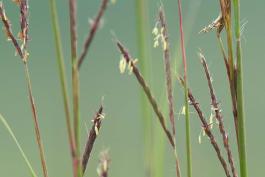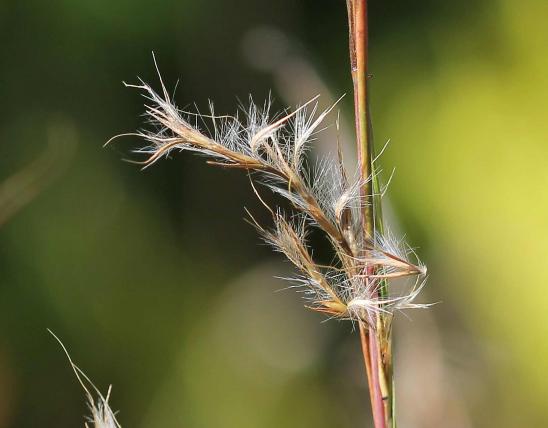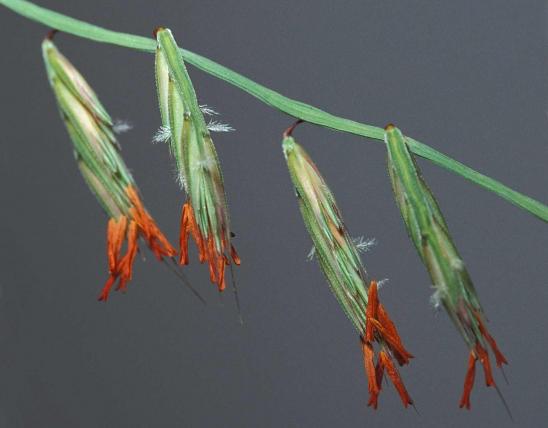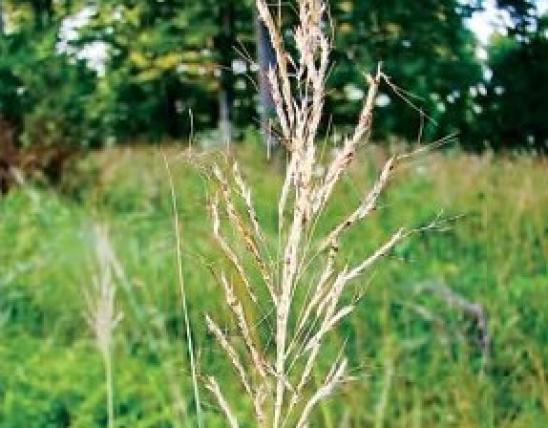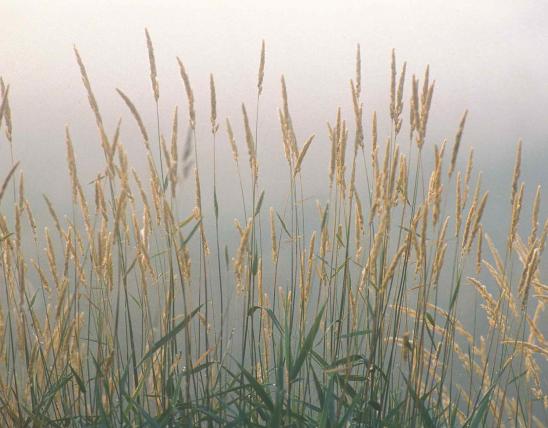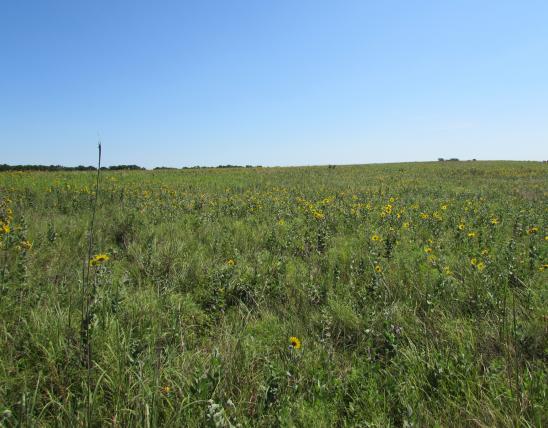
Big bluestem is a native warm-season perennial tall grass that forms dense clumps. It has been called the prince of the tallgrass prairie. It grows from short, scaly rhizomes and roots that saturate the top 2 feet of soil and often extend 12 feet below the surface. The foliage emerges grayish or bluish green in spring; in summer, it becomes green with red tinges; in fall, frosts turn it reddish bronze with hints of lavender. The flowering stalks are round in cross-section, tall, usually not branching. Flower heads are 2–4 inches long and branch into 3 fingerlike parts, resembling a turkey foot. The flowers are purplish, yellowish, or yellowish brown. Flowers and fruits June–September.
Similar species: Three other species of Andropogon live in Missouri, all about 2–4 feet tall:
- Splitbeard bluestem (A. ternarius) is scattered mostly in the southern third of Missouri; it bears twin, upright, fluffy, silvery, 2-inch-long seedheads at the stalk tips; stalks can be branched or unbranched; there is usually not a leafy sheath subtending the flowerheads.
- Our two broomsedges are notable for turning golden orange and remaining upright long into the winter:
- Virginia broomsedge (A. virginicus) is common in southern and central Missouri; its stalks branch freely; its downy, fuzzy flowers are partly enclosed by a leafy sheath; it turns coppery-gold in fall and winter.
- Elliott’s broomsedge (A. gyrans, formerly A. elliottii) is scattered in southern and central Missouri; it is quite similar to Virginia broomsedge, but the uppermost leaves (subtending the flowering stalks) are noticeably inflated, and the long, whiskerlike awns protruding from flowerheads are loosely twisted.
Flowering stems can be 2 to nearly 10 feet tall, reaching the greater heights in moister soils. Leaf blades can reach about 20 inches long.
Common throughout the state, though apparently absent from the Bootheel.
Habitat and Conservation
Occurs in upland prairies, glades, savannas, and openings of dry upland forests; also pastures, roadsides, and railroads. Big bluestem is a major component of native tallgrass prairie vegetation. Many people plant small “prairie patches,” and big bluestem is usually a component in these plantings.
Status
Native perennial warm-season sod-forming tall grass.
Human Connections
Big bluestem is considered highly desirable by livestock producers as well as by ecologists. The other members of the genus (notably the broomsedges) are weedy and are usually considered undesirable as pasture plants.
Big bluestem is an excellent forage grass for livestock, but it should not be grazed shorter than about 6 inches. It is considered highly desirable both as fodder and for production of hay.
The genus name, Andropogon, means “man” (andro) and “beard” (pogon) — a reference to the fluffy seed heads that many of its members have — and the common name for this genus is “beard grass.”
Big bluestem and our other native prairie plants, over thousands of years of sending their roots deep into the earth, and living and dying, created the vast expanses of deep, fertile soils of the Great Plains. Plowed up and converted to cropland, this region today is arguably the breadbasket to the world.
In areas where this grass is common, its pollen can be a source of hay fever.
Big bluestem can be grown in landscapes as an ornamental grass, looking good in winter, and it is nice in dried flower arrangements. It tolerates dry soils and drought, erosion, air pollution, deer, and proximity to black walnut trees. With its extensive root system, it is a great choice for erosion control.
Ecosystem Connections
Big bluestem is one of the dominant plants of our native tallgrass prairie. The ecosystems of prairies depend largely on big bluestem the way our hardwood forests depend on their dominant oaks and hickories. In a roundabout, but very real way, we cannot have Henslow’s sparrows, prairie-chickens, regal fritillaries, grassland crayfish, Mead’s milkweed, prairie fringed orchids, and a host of other prairie-restricted species without big bluestem.
Big bluestem and other native prairie grasses — and prairies themselves — are disturbance-adapted: they thrive best when occasional fire or other disturbance removes old dead leafy vegetation and keeps woody plants from getting established. Historically, fires were set by Native Americans; other disturbance included the rather random patterns of heavy grazing and trampling by vast herds of American bison.
